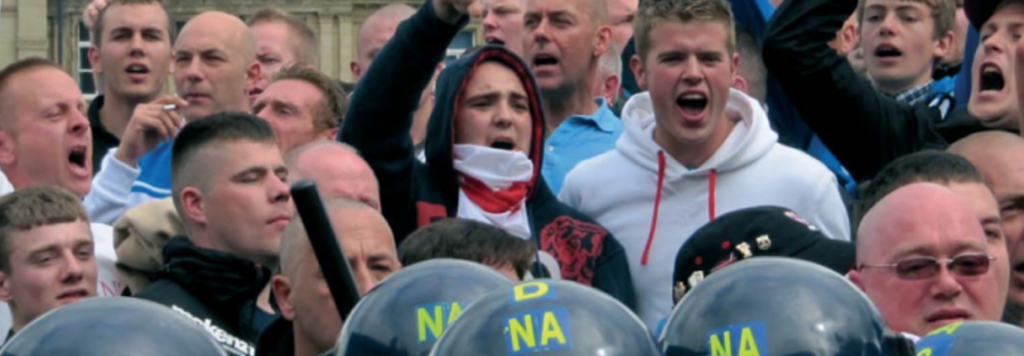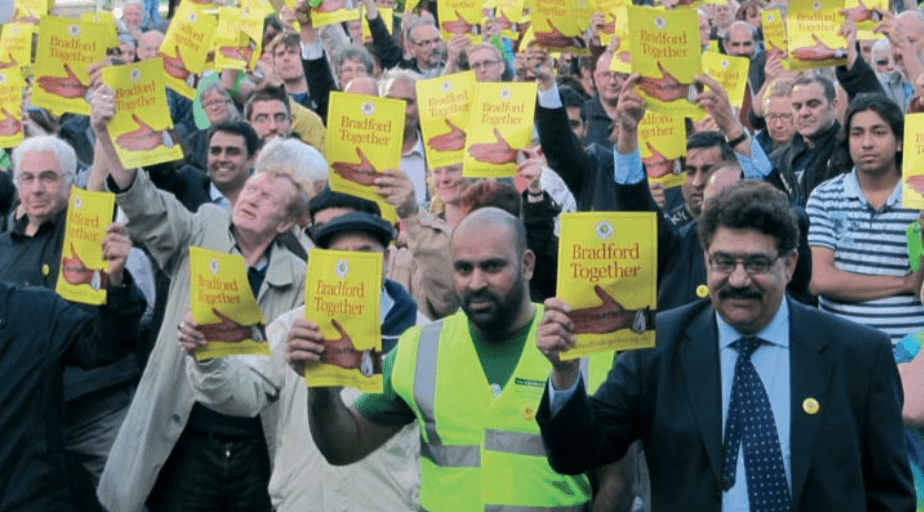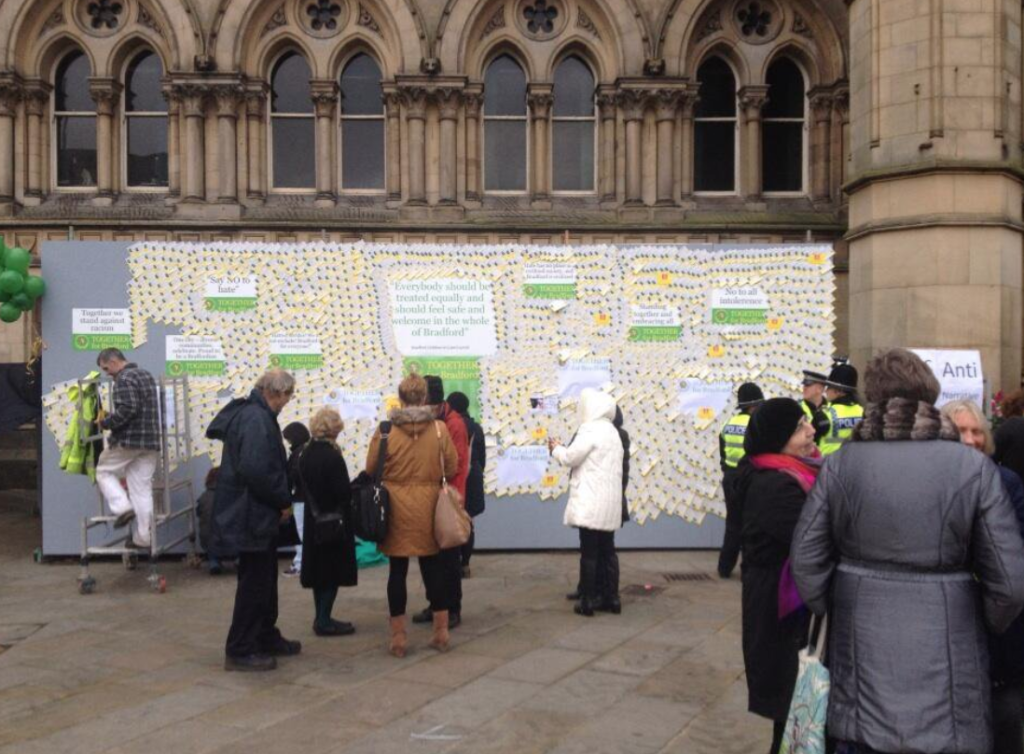HOPE not hate uses cookies to collect information and give you a more personalised experience on our site. You can find more information in our privacy policy. To agree to this, please click accept.
|
A HOPE not hate organiser and a group of volunteers worked hard to prevent a march by the virulently anti-Muslim English Defence League (EDL) in Bradford, which was intended to provoke a response similar to the riots Bradford had previously experienced in 2001.
HOPE not hate and the network of volunteers worked with local and national police, various community actors and multiple communities to present a united front against the EDL’s divisive messages and ban a march through the city. They also used those from within the Asian community in Bradford to advise Muslim youth against meeting and potentially clashing with the EDL protest.
Seventeen years ago, a tiny National Front demonstration stoked tensions and triggered riots that lasted three days and caused £10 million of damage in Bradford, West Yorkshire. There had been heightened tensions between the growing Asian, mostly Muslim, minority community and the white majority in the city.
“It was a hot day, people were getting bored and things quickly spiralled out of control. More than 200 Muslims went to prison and the scars of that riot hung over that city for a decade,” says Nick Lowles, HOPE not hate’s founder.
Youth from the city’s ethnic minority communities confronted police and attacked white people in the area, which led to white youths attacking ethnic minorities in their area.
When the EDL decided to hold a provocative march in 2010, HOPE not hate regional organiser Paul Meszaros recruited volunteers to organise a response to the march.
“There was a quiet grim determination in the city to prevent those kinds of riots again,” says Paul.
The response to the EDL march was multifaceted but rested on bringing together a coalition of different actors. HOPE not hate spoke to the council, the local police, the local newspaper, the Catholic church, trade unionists, the chamber of commerce and other local groups.
One of the first actions was a petition to ban the march. Paul stresses that they didn’t just go to a mosque and collect signatures but deliberately focused on white communities in Bradford.
“The point was that we went everywhere. We knew we needed everyone on board – not just leftists,” says Paul.
Paul also reached out to the local newspaper, which published the petition of 10,000 names. A crucial aspect of all this, he explains, was building up Bradford’s resilience to EDL-like groups using dialogue – “each signature represented a bit of conversation”.
While then-Home Secretary Theresa May could not ban a static protest, she did ban the march the EDL had planned across the predominantly Muslim areas and through the town centre. Instead EDL supporters were only allowed to protest in an empty lot, surrounded by police.
“[The EDL] just looked silly. The police had a good night as they were seen to be on the side of the Bradfordians rather than against them. The next morning, an imam and a bishop went to bless the site to cleanse it,” says Paul, laughing.

“On a bureaucratic level, whether it is the council or the police, it is difficult to deal with authorities who don’t necessarily wish to partner up with people who are not in authority, so as not to lose control,” says Nick Lowles.
Coordinating with the local council and a wide range of different groups was not always easy, adds Paul, and HOPE not hate had to work hard to build trust and communication.
While the local police, many of whom had witnessed the riots in Bradford, were cooperative, HOPE not hate faced bureaucratic barriers higher up the chain of West Yorkshire police.
Then-Home Secretary Theresa May disapproved of the campaign to ban the march.
“It had been made clear that [May] would look unfavourably at the police in terms of funding and it’s a big thing for the police to go to the Home Secretary to say ‘we can’t control a demonstration’,” says Nick.
Another difficulty HOPE not hate encountered in planning a collective response to the march was from traditional anti-fascists, who wanted to organise a counter-demonstration.
HOPE not hate has always advocated against confronting far-right rallies directly, so as not to increase the publicity for far-right demonstrators and avoid any potential violence with protesters.

“Even though progressives often want a counter-demonstration, we were never going to have enough people to physically stop the EDL and it also meant fighting and people going to prison – and it wouldn’t have been the people marching with the EDL,” says Nick.
Members of the extreme Muslim movement Hizb ut-Tahrir were also encouraging people to come and counter-demonstrate. HOPE not hate had strong connections in the Muslim community of Bradford and made a strong effort to engage with those who were now in their 30s and remembered the 2001 riots (some had gone to prison as a result).
“These men had credibility with Muslim youth and they were much more effective when they said ‘stay away from the city centre, don’t get provoked, don’t get caught up because it will be you who will go to prison’,” says Nick.
“This campaign underscored the need to reach out to people from all communities, to negotiate and cooperate with a wide range of groups in the city. It’s when we all came together that it worked,” says Paul.
HOPE not hate both lobbied behind the scenes and built a coalition to ensure the weight of public opinion was on its side. Rather than making it a bureaucratic ban pushed by the council onto the police to prevent the EDL march, HOPE not hate framed the agenda as the whole community combating the EDL’s divisive message.
The EDL twice tried to come back to the city but each time failed to provoke the reaction it was hoping for.
Instead, Paul and a group of volunteers organised a festival to bring people together and sent out thousands of postcards, inviting people to write why the EDL shouldn’t be allowed in. Thousands of these were hung up around the town centre as decoration.
The next day, the local newspaper’s headline was: “‘Wall of Peace’ shows why hope not hate will define the future of the city.”

The bridges built between the different groups through the campaign were also useful in strengthening long-term communication in the community. Local police then notified HOPE not hate whenever the EDL planned further activities around Bradford.
The partnership only worked because HOPE not hate had been active in the area for several years, building up trust and communication.
While the campaign was a success, Nick suggests they could have done more outreach work following the campaign if they had more resources in the area.
“In the progressive world, we focus on the event itself, but we don’t follow up on the legacy,” he says.

Right-wing comic Kearse saves the worst material for his anonymous Telegram account HOPE not hate has identified an anonymised Telegram account belonging to the GB…